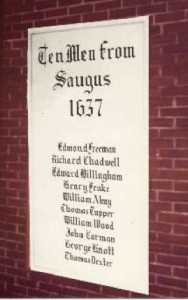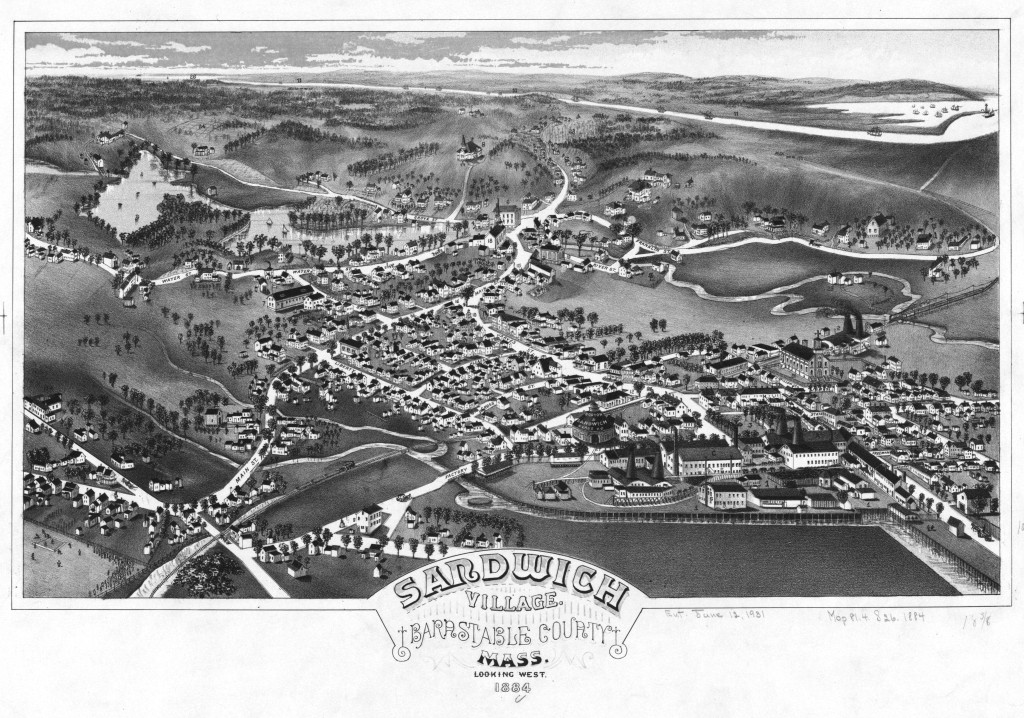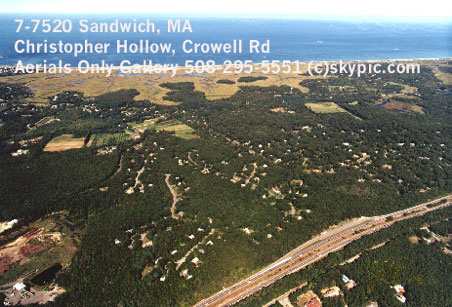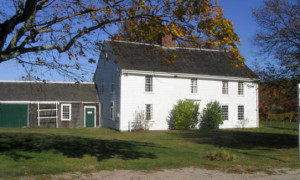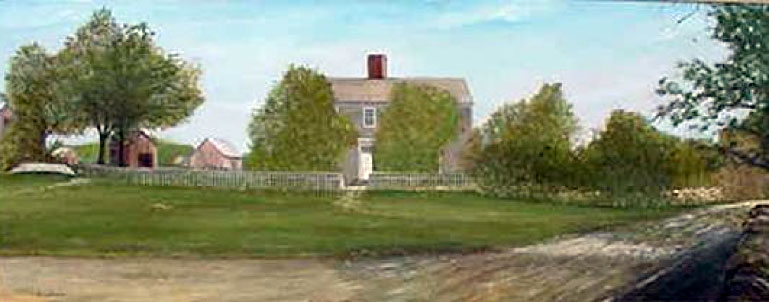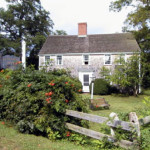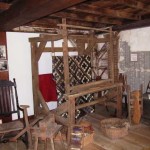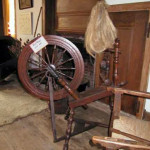The Dillingham, Wing, Tupper, and Nye Families
Sandwich, Massachusetts was the first town in Cape Cod. The “Ten Men of Saugus,” as they were called, founded Sandwich, Mass., in 1637, by the authority of the Plymouth Colony:
“It is also agreed by the Court that those tenn men of Saugust . . . shall have liberty to view a place to sitt down & have sufficient lands for three score famylies, upon the conditions propounded to them by the Governor and Mr. Winslowe.” (1)
Sixty people walked together 100 miles from Saugus (now Lynn, Mass.) to an area in the wilderness where they would create Sandwich.
We have ancestral links to its founding. Two of our ancestors, Edward Dillingham and Thomas Tupper, are among the “ten men of Saugus,” and two others, Deborah Wing and Benjamin Nye, were among the original 60 families. Evidence of their habitation there still exists and can be viewed by visitors to Cape Cod.
Although the main purpose of the new town was to create economic opportunity through farming and fishing, the town also became an arena where religious differences were fought out.
The Quakers
The Quakers started arriving in New England in the 1640s and were severely persecuted by the authorities, who objected to tenets of their religion and also their refusal to pay church taxes. Quakers risked public whippings, imprisonment, banishment, steep fines, and some possibility of execution for practicing their religion, even though they had come to New England for the same reason that the Puritans had – to live in a place free of English oppression. The leaders of the Bay Colony also punished citizens who in any way aided the Quakers, and prohibited people from listening to them preach.
Sandwich from its founding was less rigid in religious matters than other New England towns. When the Quakers started to arrive, they found people in Sandwich who were sympathetic and interested. However, the toleration for Quakers did not extend to officials of the town or of the Colony of which they were a part. Individuals who sympathized with or aided the Quakers were subject to stiff fines and imprisonment.
Eventually, the Quakers won over many of the citizens of Sandwich. James Cudworth, a Puritan, wrote in a letter of 1658: “They have many meetings and many adherents; almost the whole town of Sandwich is adhering towards them. . . The Sandwich men may not go to the Bay [Boston colony], lest they be taken up for Quakers.” (2)
The first Quaker meeting in America was established in Sandwich in 1658, with a congregation of 17 families. It was not allowed to meet in town, but met covertly in a wilderness about a mile away, now called ‘Christopher Hollow.’ This area still exists and is open to tourists.
The Dillingham and Wing Families
The Dillingham and Wing families are a part of the Quaker history of Sandwich. Edward and Ursula Dillingham, both born in Cottesbach, Leicestershire, England, came to America in about 1635 with three children, settling first at Saugus, and then becoming a founding family of Sandwich. Edward Dillingham was a farmer, and served on many juries, commissions and boards until his death in about 1667. He was part of the climate of opinion in Sandwich which was open to the ideas of the Quakers, and in 1657 he came into conflict with the civil authorities of the town: “he was arrested and admonished for showing sympathy with the Quakers, and for ‘speaking approbriesly to the cunstables deputie of Sandwich was admonished and cleared.’” The Dillinghams became Quakers themselves, and were early members of the Quaker meeting in Sandwich. Their descendants were active in this meeting for many years.
One of the Dillingham daughters, Oseath, married Stephen Wing, also a Sandwich resident. Stephen’s mother, Deborah Batchiler Wing, was the widow of a Puritan minister, John Wing. After her husband died in England, she came to New England with her four sons. She was among the 60 people who walked 100 miles from Saugus, Mass. to the wilderness which would become Sandwich in 1637.
Deborah’s father, Stephen Bachiler, was a noted individualist in New England. He was a Puritan minister who was in constant trouble with the authorities. According to historian Robert Charles Anderson, “Among many remarkable lives lived by early New Englanders, Bachiler’s is the most remarkable. From 1593, when he was cited before Star Chamber, until 1654, when he last makes a mark on New England Records, this man lived a completely independent and vigorous life, never acceding to any authority when he thought he was correct.” (4)
Perhaps Stephen Bachiler’s daughter Deborah had some of his spirit and imbued it in her sons, because two of them, Daniel and Stephen, became strong public advocates for toleration of the Quakers and suffered punishments as a result. They refused to take the Oath of Fidelity to the government because the Oath required that they cooperate in the persecution of Quakers, and were fined heavily. They both joined the Sandwich Quaker meeting in the early days of its founding. (5)
Stephen and Oseah Dillingham Wing, our direct ancestors, lived in the Wing family home. This house, pictured at left, was built in 1641 and was occupied continuously by Wing descendants until it was taken over by the Wing Family Association. It is the oldest house in New England owned and occupied continuously by the same family for over three centuries. It has been restored and is open to the public. (6)
The Tuppers and Nyes
Our Sandwich ancestors the Tuppers and Nyes did not become Quakers. Thomas and Anne Tupper were among the original settlers of Sandwich, arriving from Saugus in 1637. Born in Sussex, England, Thomas made several voyages to America in the 1620s, working as a ship’s carpenter. He was one of the original ten founders of Sandwich, settling there with his third wife, Anne, and two children by a previous marriage. Sandwich was without a settled minister for many years, and Thomas acted as a lay minister for the church. He also served on various juries, boards, and commissions, and was involved in missionary work with the Indians. He accrued large landholdings and was a wealthy citizen by the time he died in 1676.
“The painting shown here is from a photograph taken about 1890 of the Thomas and Anne Tupper homestead on Tupper Road in Sandwich, Mass. The house was built by them in 1637 and stood for almost three hundred years before it was destroyed by fire in 1921.” (7)
Benjamin Nye, born in 1620 in the County of Kent, England, came to America in 1635 as a young man. He was one of the first settlers of Sandwich and served the town as a constable, jury man, and supervisor of highways. In 1640 he married Katherine Tupper, the daughter of town founder Thomas Tupper, and they raised eight children. They were farmers and also built a town mill on a nearby creek. The Nye house is still standing, and is now the Benjamin Nye Homestead & Museum. The house has been restored in colonial style, and is open to the public. (8)
Interior Views of the Nye Homestead and Museum
The museum shows how day to day life was lived in early colonial times. These photos show an important occupation of colonial women – weaving and spinning. Other photos of the interior of this house are available at the Nye family association website, www.nyefamily.org
These Sandwich families are of interest to us because they are among our earliest ancestors in America. Their history reveals a Quaker strain that runs through our ancestry, and also shows a family tradition of religious toleration. It is intriguing that two of the homes of our ancestors are still standing in Sandwich, along with street names, markers, cemeteries, and other places, which were part of the lives of these early American relatives. It is still possible today to visit Cape Cod and get in closer touch with these ancestors.
How you are related to our ancestors in Sandwich, Massachusetts
On your personal Ancestor Fan, go to Hulda Nye on the outermost rim. Then, click here to open the Hulda Nye Ancestor Fan.
Footnotes
1. R.A. Lovell, Jr. Sandwich, A Cape Cod Town, citing the Plymouth Colony Records of 3 April 1637
2. John H. Dillingham, The Society of Friends in Barnstable County, Massachusetts, New York. H.W. Blake & Co., 1891, p. 1.
3. John H. Dillingham, The Society of Friends in Barnstable County, Massachusetts, New York. H.W. Blake & Co., 1891, p. 12 and following. Edward Dillingham: One of the Ten Men of Saugus. www.wingingit.goldwinghome.com/ten%20men%20of%20saugus/edwarddillingham.html
4. Robert Charles Anderson, The Great Migration Begins: Immigrants to New England 1620-1633, Volumes I-III (Online database: NewEnglandAncestors.org, New England Historic Genealogical Society, 2002.
5. Conway P. Wing, A Historical and Genealogical Register of John Wing, of Sandwich, Mass. New York: The De Vinne Press, 1888. Pp. 37-47; 53-55.
6. See the Wing Family Association website, www.wingfamily.org
7. See the Tupper Family Association website, www.tupperfamily.org
8. See the Nye Family Association website, www.nyefamily.org

